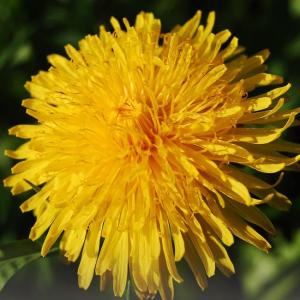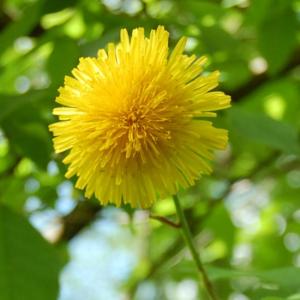
DANDELION PLANT (TARAXACUM OFFICINALE) - PLANTS

BASE / GENERAL DATA
Information submited: June 9, 2015 Modified: May 15, 2018 By: OperaDreamhouse
Taraxacum Officinale, the Common Dandelion, is a flowering herbaceous perennial plant of the family Asteraceae. It can be found growing in temperate regions of the world, in lawns, on roadsides, on disturbed banks and shores of water ways, and other areas with moist soils. Taraxacum Officinale is considered a weed, especially in lawns and along roadsides.
Taraxacum Officinale is native to Eurasia and now is naturalized throughout North America, southern Africa, South America, New Zealand, Australia, and India.
Taraxacum Officinale grows from generally unbranched taproots and produces one to more than ten stems that are typically 5 - 40 cm tall, but sometimes up to 70 cm tall. Plants have milky latex and the leaves are all basal: each flowering stem lacks bracts and has one single flower head. The yellow flower heads lack receptacle bracts and all the flowers, which are called florets, are ligulate and bisexual. The fruits are mostly produced by apomixis.
The leaves are 5 - 45 cm long and 1 - 10 cm wide, and are oblanceolate, oblong, or obovate in shape, with the bases gradually narrowing to the petiole. The leaf margins are typically shallowly lobed to deeply lobed and often lacerate or toothed with sharp or dull teeth.
The calyculi (the cuplike bracts that hold the florets) are composed of 12 to 18 segments: each segment is reflexed and sometimes glaucous. The lanceolate shaped bractlets are in two series, with the apices acuminate in shape. The florets number 40 to over 100 per head, having corollas that are yellow or orange -y ellow in color.
The fruits, called cypselae, range in color from olive-green or olive - brown to straw - colored to grayish, they are oblanceoloid in shape and 2 - 3 mm long with slender beaks. The fruits have 4 to 12 ribs that have sharp edges. The silky pappi, which form the parachutes, are white to silver - white in color and around 6 mm wide.
The name of the genus, Taraxacum, is derived from the Greek Taraxos (Disorder), and Akos (Remedy), on account of the curative action of the plant. A possible alternative derivation of Taraxacum is suggested in The Treasury of Botany:
"The generic name is possibly derived from the Greek Taraxo ("I have excited" or "Caused") and Achos (Pain), in allusion to themedicinal effects of the plant".
Taraxacum Officinale is native to Eurasia and now is naturalized throughout North America, southern Africa, South America, New Zealand, Australia, and India.
Taraxacum Officinale grows from generally unbranched taproots and produces one to more than ten stems that are typically 5 - 40 cm tall, but sometimes up to 70 cm tall. Plants have milky latex and the leaves are all basal: each flowering stem lacks bracts and has one single flower head. The yellow flower heads lack receptacle bracts and all the flowers, which are called florets, are ligulate and bisexual. The fruits are mostly produced by apomixis.
The leaves are 5 - 45 cm long and 1 - 10 cm wide, and are oblanceolate, oblong, or obovate in shape, with the bases gradually narrowing to the petiole. The leaf margins are typically shallowly lobed to deeply lobed and often lacerate or toothed with sharp or dull teeth.
The calyculi (the cuplike bracts that hold the florets) are composed of 12 to 18 segments: each segment is reflexed and sometimes glaucous. The lanceolate shaped bractlets are in two series, with the apices acuminate in shape. The florets number 40 to over 100 per head, having corollas that are yellow or orange -y ellow in color.
The fruits, called cypselae, range in color from olive-green or olive - brown to straw - colored to grayish, they are oblanceoloid in shape and 2 - 3 mm long with slender beaks. The fruits have 4 to 12 ribs that have sharp edges. The silky pappi, which form the parachutes, are white to silver - white in color and around 6 mm wide.
The name of the genus, Taraxacum, is derived from the Greek Taraxos (Disorder), and Akos (Remedy), on account of the curative action of the plant. A possible alternative derivation of Taraxacum is suggested in The Treasury of Botany:
"The generic name is possibly derived from the Greek Taraxo ("I have excited" or "Caused") and Achos (Pain), in allusion to themedicinal effects of the plant".

SPIRITUAL PRACTISES DATA

MEDICINE / HEALTH DATA
Information submited: June 9, 2015 Modified: May 15, 2018 By: OperaDreamhouse
The first mention of the Dandelion as a medicine is in the works of the Arabian Physicians of the tenth and eleventh centuries, who speak of it as a sort of wild Endive, under the name of Taraxcacon. In this country, we find allusion to it in the Welsh medicines of the thirteenth century. Dandelion was much valued as a medicine in the times of gerard and parkinson, and is still extensively employed.
Dandelion roots have long been largely used on the Continent, and the plant is cultivated largely in India as a remedy for liver complaints.
Dandelion roots have long been largely used on the Continent, and the plant is cultivated largely in India as a remedy for liver complaints.

BEAUTY / COSMETICS DATA

FOOD / COOKING DATA
COMMENTS
No comments.
Newest mixtures containing Dandelion Plant (Taraxacum Officinale):

Home made wild dandelion honey
June 10, 2015



